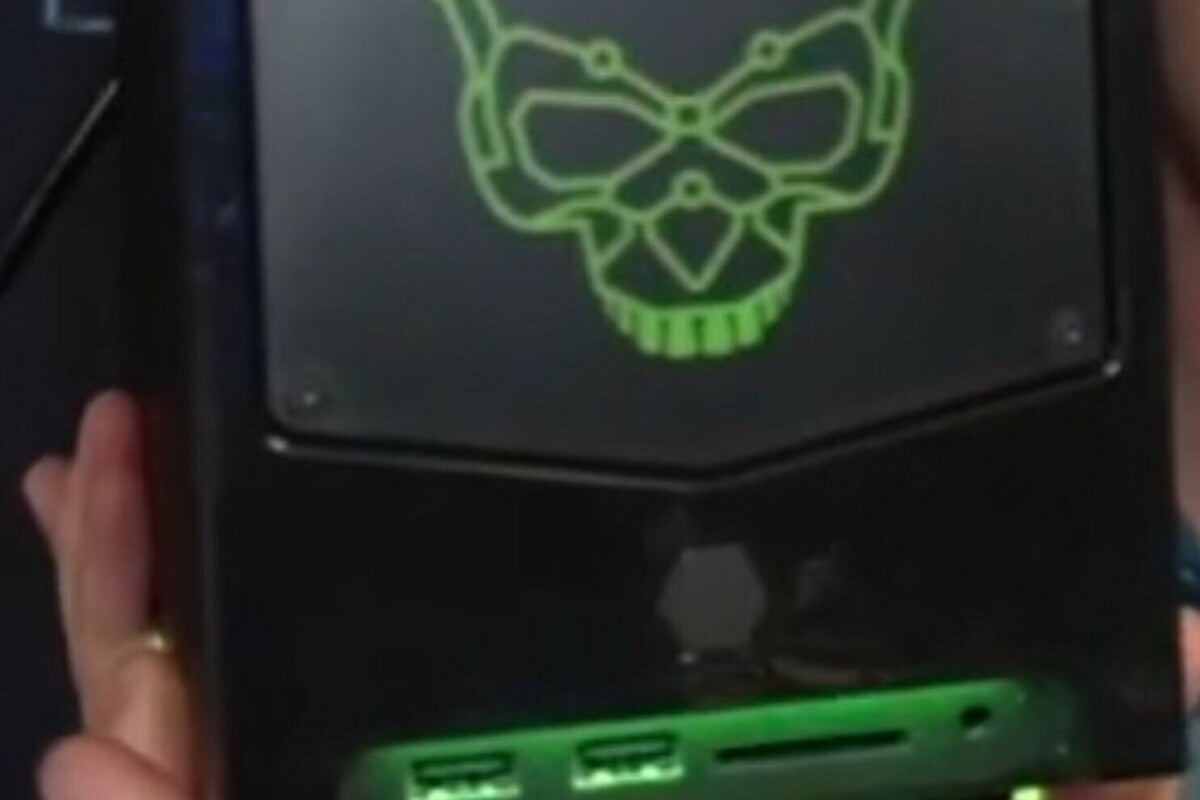Can this gigantic NUC win over fans of small-form-factor builds?

Intel
Today’s Best Tech Deals
Picked by PCWorld’s Editors
Top Deals On Great Products
Picked by Techconnect’s Editors
Back at CES 2020, Intel introduced a much larger Next Unit of Computing (NUC) bare-bones mini-PC than had ever previously been shown—a 5L modular gaming PC that had room for a discrete graphics card. Now at Computex 2021, Team Blue on Sunday gave an early, brief glance at Ghost Canyon’s successor: the 8L Intel NUC 11 Extreme Kit, also known as Beast Canyon.
This hefty newcomer doubles down on Ghost Canyon’s formula, which used its extra real estate to promote the idea of ultra-easy DIY PC building. No need to study up on the ins and outs of PC building: On one side of the case, you drop in Intel’s Compute Element, a self-contained PC in the form of a PCIe card. Powered by a beefy H-class mobile processor, it also holds the RAM and storage. On the other side, you install an add-in graphics card that can handle the most punishing of games. That’s it. But this time, full-length cards will fit.
That’s right: Beast Canyon accommodates graphics cards up to 12 inches in length, and, judging by the early look we got during a press briefing, up to at least 2 slots thick. With Ghost Canyon, you had to settle for small-form-factor cards, which are more limited in selection and often performance as well.
Of course, that real estate has to come from somewhere, and Beast Canyon’s footprint is accordingly larger than its predecessor’s. This NUC lands firmly in small-form-factor territory with a volume of 8L.
 PCWorld / Intel
PCWorld / IntelDon’t be fooled by its front profile: Beast Canyon dwarfs its traditional 4 x 4-inch square siblings, and even the VHS-tape-sized NUC Enthusiast gaming models. This sample shown to us only has the Compute Element inside, but no discrete graphics card.
Given that Intel launched a gaming-focused Tiger Lake NUC earlier this year, seeing Beast Canyon join the lineup may seem surprising. January’s announcement of Phantom Canyon continued Intel’s original line of gaming-oriented NUCs—wide, flat, but still compact devices with names like Skull Canyon and Hades Canyon that easily fit in a backpack’s front pocket—after a three-year hiatus. You could easily assume that a successor to Ghost Canyon would follow in 2022 or 2023.
But Phantom Canyon sports a U-class Tiger Lake processor, and Intel says it considers Beast Canyon an extension of its H-series mobile chips that were announced earlier this month. The new NUC 11 Extreme Compute Elements will come in Core i5, Core i7, and Core i9 variants, with the processors rated at up to a 65W TDP.
 PCWorld / Intel
PCWorld / IntelThe NUC 11 Extreme Compute Element’s apparent changes include the move to just one ethernet port, down from two on the NUC 9 model.
Presumably, the advent of Tiger Lake H is the reason for the unexpected appearance of Beast Canyon, rather than a major overhaul to the Compute Element itself. Comparing the back view of the NUC 11 Extreme Compute Element with the current NUC 9 version, both share a similar assortment of I/O ports. The changes appear to be minor: This sneak peek shows only one ethernet port now instead of two, plus two additional USB Type-A ports. The cooling for the new Compute Element may also be updated, as its vents differ from those of its predecessor.
More dramatic is Beast Canyon’s apparent aesthetic shift. Intel has jettisoned Ghost Canyon’s minimalist, matte look in favor of what appears to be glossy black plastic and mesh, with a boxy, early-2000s vibe. (The chunky plastic vents on the top panel, plus the front panel’s thick, rounded edges, particularly stood out for us.) RGB light effects have been amped up, too—you’ll see it in Intel’s skull logo, which looms startlingly large on the front panel, as well as in the accent lighting over the front I/O ports. More is more with Beast Canyon.
That philosophy could harm Beast Canyon at launch, which Intel says will be later this year. With its growth in size, this NUC will compete directly against small-form-factor PCs, and such a fight may prove more than it can handle. At 8L, building a comparable small-form-factor PC isn’t as gnarly or potentially frustrating as it is with a 5L system. Intel rightly could boast Ghost Canyon’s better cooling and ease of building were a worthwhile trade for flexibility and customization. It could also better justify the high starting price: Ghost Canyon’s Core i5 version cost $1,250 and went all the way up to $1,700 for the Core i9 model.
 PCWorld / Intel
PCWorld / IntelIntel’s Beast Canyon NUC sports much more RGB than the company’s previous gaming NUCs.
That justification fades around the edges when you look at the DIY alternatives. The lure of a true DIY build with a desktop CPU and sleek vibe could end up holding more sway over gamers wanting to build small. Just have a peep at /r/sffpc on Reddit—you’ll see gorgeous, tiny PCs under 9L. Some still likely cost less than a similar, fully outfitted Beast Canyon NUC, and with a socketed processor inside, those builders will never worry about upgrades or the ease of selling that chip down the road.
If that doesn’t deter you, Intel promises more details will come soon, which should reveal how much cash Beast Canyon will devour and what kind of third-party support to expect from case makers and system builders this time around.
Note: When you purchase something after clicking links in our articles, we may earn a small commission. Read our affiliate link policy for more details.

